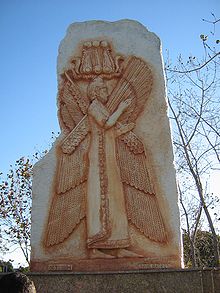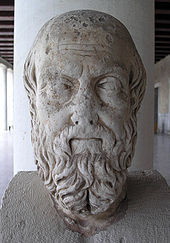Cyrus the Great
Campaigns of Cyrus the Great
Persian RevoltHybra
- Persian Border
Invasion of AnatoliaPteria
- Thymbra - Sardis
Invasion of BabyloniaOpis
- Babylon
Kyros II. (Old Persian Kūruš, New Persian کوروش بزرگ Kurosh-e bozorg, 'Kurosh the Great', Babylonian Kuraš, Elamite Kuraš, Aramaic Kureš, Hebrew כורש Koreš, Ancient Greek Κῦρος Kŷros, Latin Cyrus; * c. 590 BC. C.E. to 580 B.C.E.; † August 530 B.C.E.), often called Cyrus the Great, son of Cambyses I, ruled Persia from c. 559 bc to 530 bc as sixth king of the Achaemenid dynasty and named his son Cambyses II as his successor.
By his policy of expansion Cyrus considerably extended the borders of the formerly small Old Persian Empire, which under his successors reached from India to Iran, Babylon, Asia Minor and Egypt and existed until 330 BC, before it was conquered by Alexander the Great.
Archaeological campaigns and, in the meantime, improved transcriptions of a number of cuneiform texts led to new insights that refined the previous picture of the historical Cyrus. Soon after his death, the Persian king was transfigured by his people as an ideal king. The Greeks adopted this positive view. It was reinforced by his portrayal in the Bible as a religiously tolerant regent and continues to dominate his judgment today. His person is still regarded today as the model of a king and ruler.

Kyros II in the Olympic Park of Sydney (replica of the original from the relief in Pasargadae)
Name
The ancient historians Ktesias of Knidos and Plutarch translated the name Kyros with "sun" (Kur-u). In addition, there was an attempt to make an extension to "like the sun", since a reference to the Indo-European word root "khor" and the suffix "-vash" was established. However, this translation has since been rejected by modern research.
The interpretation is still controversial. Among other things, a derivation from the Vedic language using "Ku, ru-" to "young man or child" is considered. Linguists such as for example Karl Hoffmann and Rüdiger Schmitt translate the name with "gracious ruler over the enemies/ruler with the gracious judgment over the enemies".
Origin
Herodotus' information on the lineage of Cyrus is confirmed by the inscriptional account of Cyrus' paternal cylinder. According to this, the Persian king was a son of Cambyses I and grandson of Cyrus I. According to Herodotus, Cyrus' mother was Mandane, the daughter of Astyages, under whose suzerainty Cyrus' father Cambyses I was king of Anshan. Astyages was at this time the authoritative commander of the army with the Median title of ruler. That Astyages was therefore the maternal grandfather of Cyrus, however, cannot be proved by cuneiform finds. Ctesias disputed the statements of Herodotus and gave another genealogy of the parents of the Persian king, who according to this was not a king's son, but the son of a robber and a goat-herder. But this information proves to be wrong by comparison with the inscriptions. Evidently Ctesias, by a deliberate falsification of history, attempted to disparage the founder of the Persian empire, and therefore made him descend from lowly parents. His entire further account of the youth of Cyrus also presents him in an extremely unfavorable light. On the other hand, Herodotus' account that Astyages, warned by a dream, recognized a danger in little Cyrus and therefore wanted to have him killed, but that the infant was instead raised and thus saved, without the ruler's knowledge, by a shepherd living in the distant mountains, whose wife gave birth to a dead child who is said to have been secretly exchanged for Cyrus, is also an unhistorical legend based on older Mesopotamian models. Since no further cuneiform information exists concerning Cyrus' early years, it must be stated that nothing is known about them.
From the Cylinder inscription, the Nabonaid Chronicle, and another cuneiform text, it can be inferred that Cyrus succeeded his father Cambyses I as king of Anshan around 559 BC as a regional member of the Median confederacy.
Kyros saw himself as a descendant of Teispes and referred to himself accordingly as "Teispide". The later change of the genealogy by Darius I and the assignment of Achaimenes as the founder of the dynasty served to substantiate his claims to the throne. Today, however, the majority doubts that the Teispids as ancestors of Kyros were actually related to the Achaemenid ancestors of Darius I. Accordingly, Kyros was not an Achaemenid. Accordingly, Cyrus was not an Achaemenid.
The cuneiform tradition does not begin until the war between the Persian king and Astyages.

Bust of Herodotus (Ancient Agora Museum, Athens, no. S270).
Search within the encyclopedia